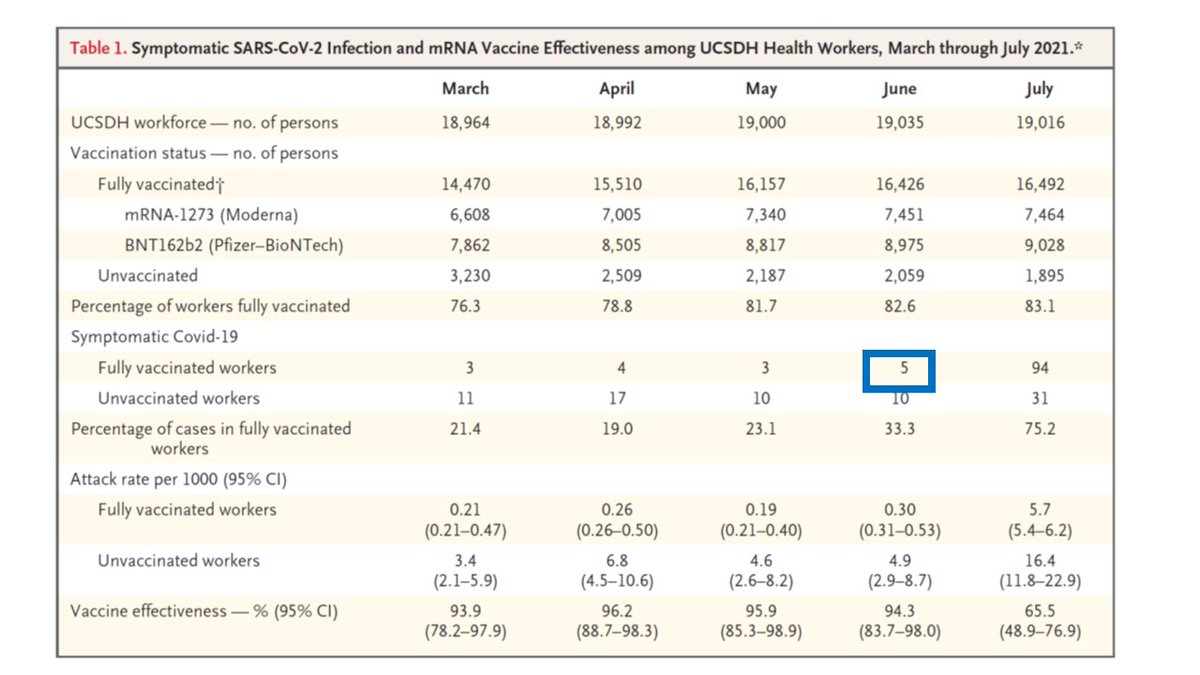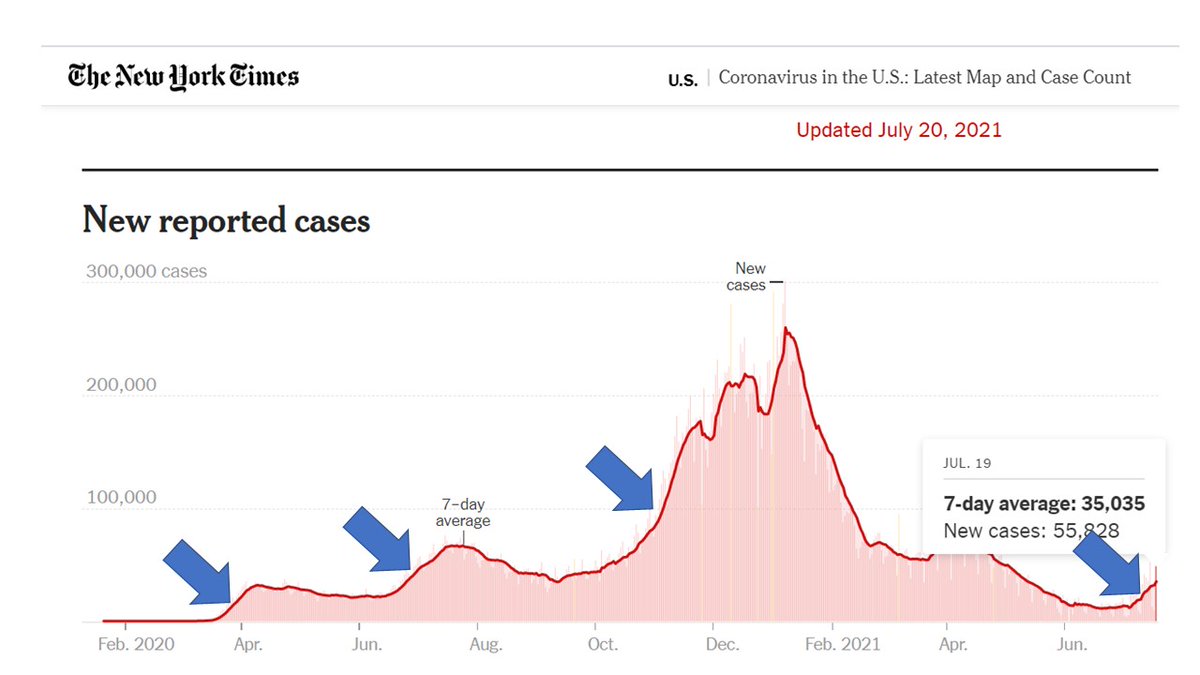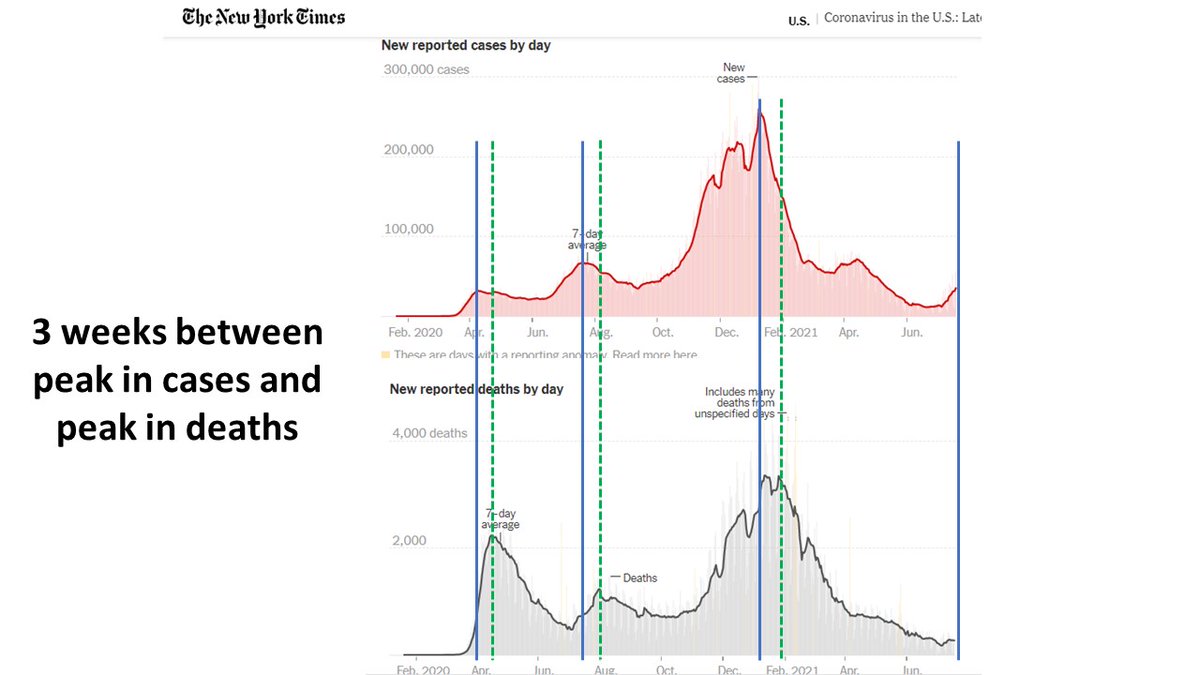
@NEJM joining the waning immunity debate. I'm going to push back a bit.
Data from @UCSDHealth of vax effectiveness in health workers: 94% in June, 65% in July. Interpreted as "likely to be due to...delta and waning immunity over time, compounded by end of masking requirements."
Data from @UCSDHealth of vax effectiveness in health workers: 94% in June, 65% in July. Interpreted as "likely to be due to...delta and waning immunity over time, compounded by end of masking requirements."

1. re: delta. ~50% of CA sequences were delta in June. So if delta were the driving factor, we would expect to see some waning of vax effect in June (~halfway between May & July) - which we don't. 

2. Same thing with waning immunity. According to the paper, vaccination started in mid-Dec, and it took 3 months to get 76% of workers vax'd. Why then would we see no waning of effect in May or June - and then a sudden drop of 30% in July?
Same for mask mandate - lifted June 15.
Same for mask mandate - lifted June 15.

3. Much of this effect reflects an 18-fold increase in cases among unvax'd workers, comparing June to July - vs. only a 3-fold increase among vax'd workers.
Worth noting that even with this huge increase, vax effectiveness vs infection still estimated at 66%, ~2/3
Worth noting that even with this huge increase, vax effectiveness vs infection still estimated at 66%, ~2/3

4. But sample size here is 15 cases in June. Let's compare to larger sample data. I couldn't find SD County cases by vax status, but we do have data in Santa Clara. See below - comparing June to July, unvax'd rate 4.1->16.7 (4x jump), vax'd 0.3->4.1 (14x).
Looks similar! But...
Looks similar! But...

5. Where is SCC now? Unvax'd case rate 59.5, vax'd 10.6. Vax effectiveness: ~5/6, over 80%.
Not waning further. If anything, vax looks *more* effective today than in July.
(Note: Pop'n of SCC >20% that of Israel.)
What gives? 3 possible explanations for the San Diego data...
Not waning further. If anything, vax looks *more* effective today than in July.
(Note: Pop'n of SCC >20% that of Israel.)
What gives? 3 possible explanations for the San Diego data...

6. 3 possibilities:
(1) Numbers before July are small & unreliable.
(2) As people have more intense contacts, vax doesn't protect against these as well. As contacts become less intense, vax more protective.
(3) One large outbreak in July (70 cases) could explain the entire jump.
(1) Numbers before July are small & unreliable.
(2) As people have more intense contacts, vax doesn't protect against these as well. As contacts become less intense, vax more protective.
(3) One large outbreak in July (70 cases) could explain the entire jump.

7. Just remember:
- Interpret small numbers w caution.
- Behavior is also changing, not just variants, time since vax, & policy.
- Shocking numbers (like in SD) get published, un-shocking ones (like SCC) don't.
- We have a strong bias toward thinking it's biology, not behavior.
- Interpret small numbers w caution.
- Behavior is also changing, not just variants, time since vax, & policy.
- Shocking numbers (like in SD) get published, un-shocking ones (like SCC) don't.
- We have a strong bias toward thinking it's biology, not behavior.
8. Footnote 1: Worth noting that booster shots are an intervention that favors the well-off.
See below in CA, for ex: 12% of best-off quartile unvax'd, vs 31% of worst-off.
We should think about how to support those with fewer resources before re-vax'ing those with more.
See below in CA, for ex: 12% of best-off quartile unvax'd, vs 31% of worst-off.
We should think about how to support those with fewer resources before re-vax'ing those with more.

9. Footnote 2: It's very likely that booster shots give a short-term immunity boost. Vaccines increase antibody production - but antibodies don't last forever.
So if you want a month of extra protection, get a booster.
But don't conflate that w reducing long-term transmission.
So if you want a month of extra protection, get a booster.
But don't conflate that w reducing long-term transmission.
Bottom line:
In many large US datasets (e.g., NY State), there is no evidence of greatly waning immunity.
Don't overinterpret 1 month of data, especially w major behavioral changes.
Vaccines still work - well.
The jury on waning immunity at the population level is still out.
In many large US datasets (e.g., NY State), there is no evidence of greatly waning immunity.
Don't overinterpret 1 month of data, especially w major behavioral changes.
Vaccines still work - well.
The jury on waning immunity at the population level is still out.
CORRECTION: 18-fold increase among vax'd, 3-fold among unvax'd. Thanks for picking this up, @mahmudme01 !
• • •
Missing some Tweet in this thread? You can try to
force a refresh













